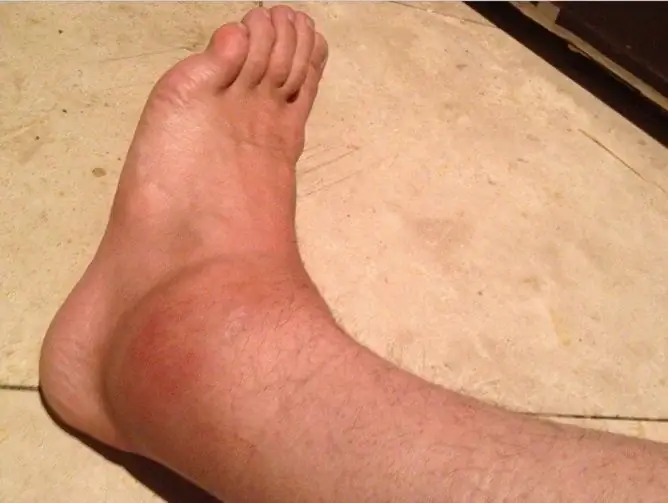- Author Rachel Wainwright [email protected].
- Public 2023-12-15 07:39.
- Last modified 2025-11-02 20:14.
Diabetic foot

Diabetic foot, or diabetic foot syndrome, is the most frequent complication of diabetes mellitus, which occurs 15-20 years after the onset of the disease when the stage of decompensation begins.
In 90% of cases, diabetic foot syndrome is diagnosed in type 2 diabetes mellitus. The disease is an ulcerative necrotic lesion of the skin, soft tissues, and in severe cases of the bone tissue of the foot. In its final stage, the diabetic foot leads to limb gangrene, which kills two-thirds of patients with type 2 diabetes.
Reasons for the development of diabetic foot syndrome
The stage of decompensation of diabetes mellitus is characterized by a high blood sugar content, as well as sharp jumps in its level. This has a destructive effect on the nerves and blood vessels, at first the vessels of the microvasculature are affected, and then the large ones. Disorders of innervation and blood supply lead to tissue trophism insufficiency. The foot is the part of the body that is under increased stress and is often injured, especially in diabetes, since the skin in diabetes is dry, and hyperkeratosis often occurs on the skin of the foot. As a result of reduced innervation, the patient does not notice minor injuries - bruises, abrasions, cuts, cracks. But in conditions of impaired blood circulation, the protective function of tissues is reduced, and any minor injury can lead to a long-term non-healing wound, which, when an infection is attached, turns into an ulcer.
Types of diabetic feet
In 1991, the First International Symposium on Diabetic Foot Symposium was held, where a classification of this disease, taking into account the predominant lesion, was developed, which was adopted as a basis by the world medical community. According to this classification, the following types of diabetic foot are distinguished:
- Neuropathic foot, in which innervation disorders prevail;
- Ischemic foot, microvascular disorders prevail;
- Neuro-ischemic foot, combining signs of the first and second forms.
The most common is the neuropathic foot, the second most frequent is the mixed form, the ischemic foot is the rarest manifestation of diabetic foot syndrome. Depending on the type, the approach to the treatment of diabetic foot and the prognosis of the disease depend.
Diabetic foot symptoms
Symptoms of a diabetic foot have their own characteristics, depending on the form of the disease.
- Symptoms of a diabetic foot, neuropathic form. It is characterized by decreased sensitivity of the foot, absence of pain, the pulse on the arteries of the feet is unchanged, the skin is of normal color. On examination, attention is drawn to the deformity of the foot, which develops due to improper distribution of the load on the bones and joints of the foot as a result of disturbed innervation. On the foot there are areas of hyperkeratosis, calluses, also caused by the redistribution of the load. For the ulcers that form with this form of diabetic foot, smooth edges are characteristic.
- Diabetic foot symptoms, ischemic form. There is no deformation of the foot and calluses, the sensitivity is preserved, the pulse on the arteries of the feet is weak or not detected. Feet cold, pale in color, often swollen. The ulcers have uneven edges and are painful.
- Symptoms of a diabetic foot with a mixed form of the disease combine signs of ischemic and neuropathic forms.

The manifestation of diabetic foot syndrome also depends on the stage of the disease. The clinic uses the Wagner classification of diabetic foot:
- Stage zero, or risk group for developing diabetic foot. The foot is deformed, there is hyperkeratosis, calluses, but no ulcers.
- The first stage of the diabetic foot. Superficial ulcer limited to the skin.
- The second stage of the diabetic foot. Deep ulcer. The process involves not only the skin, but also the subcutaneous fat, tendons, muscle tissue, without affecting the bones.
- The third stage of the diabetic foot. Deep ulcer with damage to bone tissue.
- The fourth stage of the diabetic foot. Limited gangrene.
- The fifth stage of the diabetic foot. Extensive gangrene.
Diagnostics of the diabetic foot
The diagnosis of diabetic foot syndrome is not difficult because of the history of diabetes and the characteristic clinical picture of the disease. For treatment, it is important to establish the form and stage of the process, for which a neurological examination, a detailed study of blood flow (angiography, Doppler, Doppler, etc.), blood test, X-ray of the feet, bacteriological examination of the contents of the ulcer are performed.
Diabetic foot treatment
The approach to the treatment of diabetic foot depends on the type of disease, however, in any form of the disease, the main thing is to compensate for diabetes mellitus and lower blood sugar levels, as elimination of the main damaging factor.
In the ischemic form, treatment of a diabetic foot consists in restoring blood flow to the limb, for which both therapeutic and surgical methods are used. Prescribe medications that improve blood circulation and relieve swelling, as well as antibacterial agents. Of the surgical methods, percutaneous transluminal angioplasty is used (an operation in which blood flow in the vessels is restored without cutting the skin, through a puncture in the artery); thrombarterectomy or distal vein bypass. A sparing regimen is created for the injured limb, and local treatment of ulcers with antiseptics is carried out.
Treatment of diabetic foot in neuropathic and mixed forms also consists in local treatment of ulcers, general antibiotic therapy and improvement of trophism of the feet, but special attention is paid to the restoration of normal innervation, for which drugs that improve metabolism are used. Smoking cessation is important in the treatment of diabetic feet, since tobacco has a negative effect on the microvascular bed, and in the case of smoking, most interventions may be ineffective or have only a short-term effect.
The use of folk remedies in the treatment of diabetic foot

For a patient with diabetic foot disease, folk remedies in treatment can be recommended as auxiliary ones, since with prolonged use of traditional medicine they can give a good effect. Another advantage of using them is that they are gentle and harmless.
For the treatment of diabetic feet with folk remedies, as a rule, various medicinal substances of natural origin are used in the form of baths, lotions and compresses. Decoctions and infusions of medicinal herbs - chamomile, sage, eucalyptus, celandine - are widely used. Wound-healing pastes are made based on herbs or beekeeping products, which are applied under the bandage for a period of several minutes to several hours.
However, it should be said that with the development of serious stages of the disease, you should not rely on folk remedies, since in this case, the treatment of a diabetic foot requires active medical intervention and the adoption of urgent medical care.
YouTube video related to the article:
The information is generalized and provided for informational purposes only. At the first sign of illness, see your doctor. Self-medication is hazardous to health!






